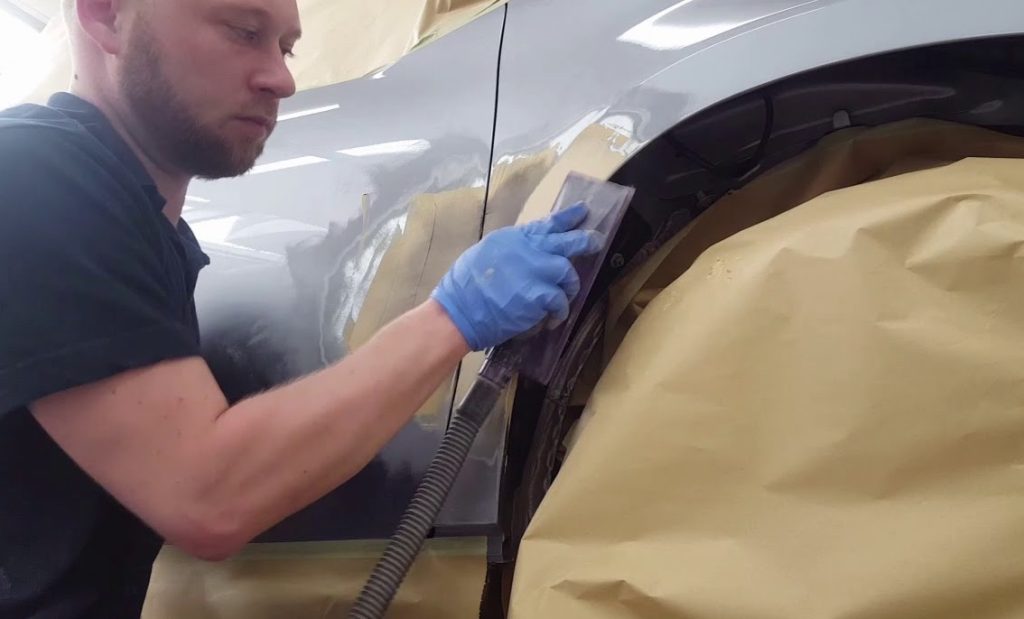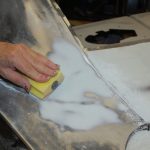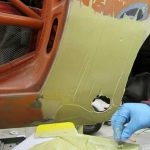If you’ve ever found yourself wondering about the durability of Bondo in your car repairs, you’re not alone. As a go-to solution for fixing minor dents and dings, Bondo, or automotive body filler, has become a staple in the DIY auto repair world. However, understanding how long Bondo repairs last involves delving into various factors, from the basics of Bondo application to expert tips for prolonging its life.
Understanding the Basics of Bondo
Before we explore the longevity of Bondo repairs, let’s take a moment to understand the basics of this versatile automotive body filler. Bondo is a putty-like substance that, when applied and cured correctly, can seamlessly repair minor imperfections in your vehicle’s body. Its malleability allows for easy shaping and sanding to match the contours of your car, making it a popular choice for DIY enthusiasts.
Factors Influencing Bondo Longevity
1. Surface Preparation Matters
The foundation of any successful Bondo repair lies in proper surface preparation. Before applying Bondo, ensure that the surface is clean, free of grease, and devoid of any contaminants. A well-prepared surface sets the stage for a strong bond between the filler and the car body, ultimately influencing the longevity of the repair.
2. Application Techniques
Applying Bondo is an art in itself. The thickness of the application matters, and finding the right balance is crucial for optimal results. Following the manufacturer’s guidelines on mixing and application is essential to achieve the right consistency and ensure the longevity of the repair.
3. Environmental Conditions
The environment in which Bondo is applied and cures plays a significant role in its overall performance. Extreme temperatures, high humidity, or direct sunlight can impact the curing process. For the best results, work in a controlled environment that allows for proper drying and curing of the Bondo.
Expert Tips for Prolonging Bondo Life
1. Choose Quality Products
The foundation of any durable Bondo repair begins with the choice of products. Investing in high-quality Bondo from reputable brands is a critical first step. These products are formulated to deliver the best results, ensuring longevity and resilience in your auto repairs.
2. Thoroughly Sand and Prime
Preparing the surface is not a step to be rushed. Thoroughly sanding the area and using a quality primer create an ideal foundation for the Bondo filler. This not only promotes better adhesion but also enhances the overall durability of the repair.
3. Avoid Overreliance on Bondo
While Bondo is a reliable solution for minor damages, it’s essential not to overuse it. Using Bondo for extensive damage may compromise the structural integrity of your vehicle. In such cases, consider seeking professional repairs or alternative methods to ensure a robust and lasting solution.
How Long Can You Expect Bondo Repairs to Last?
The durability of Bondo repairs is subject to various factors. When applied correctly and under optimal conditions, Bondo can last for several years. However, it’s essential to be vigilant and monitor the repaired areas for signs of wear.
Signs That Bondo Repairs Might Need Attention
- Cracking: Small cracks on the Bondo surface can be an early indication of weakening. Regular inspection can help catch these issues before they escalate.
- Fading or Discoloration: Changes in color, especially in exposed areas, may suggest UV damage. Addressing these areas promptly can prevent further deterioration.
- Peeling: If Bondo begins to peel or flake, it’s a clear sign that the bond with the surface is compromised. Prompt attention to these issues can prevent more extensive damage.
Monitoring and Maintenance for Longevity
Ensuring the longevity of Bondo repairs doesn’t end with the application process. Regular monitoring and maintenance are key components of a lasting solution. Here are additional tips to consider:
1. Waxing and Polishing
After the Bondo has fully cured, consider waxing and polishing the repaired area. This not only enhances the aesthetic appeal but also provides an extra layer of protection against the elements. (See Also: Can You Paint Over Epoxy Primer? A Step-by-Step Guide)
2. Regular Inspections
Incorporate regular inspections into your vehicle maintenance routine. Pay attention to the areas where Bondo was applied and look for any changes in appearance or texture. Early detection of issues allows for timely intervention.
3. Addressing Small Issues Promptly
If you notice any of the early signs mentioned earlier, don’t procrastinate. Addressing small issues promptly can prevent them from escalating into more extensive and costly repairs.
Expert Tips for Mastering Bondo Repairs: Ensuring Longevity and Quality Results
When it comes to Bondo repairs, mastering the art is not just about the application process; it’s about ensuring those repairs stand the test of time. Here are some expert tips to elevate your Bondo game and guarantee lasting and high-quality results in your auto body repairs.
1. Invest in Quality Bondo Products
The foundation of a durable Bondo repair starts with the products you use. Opt for high-quality Bondo fillers from reputable brands. These formulations are engineered for superior adhesion and longevity, ensuring your repairs withstand the challenges of time and the elements.
2. Follow Manufacturer Guidelines to the Letter
Bondo application is a science, and the manufacturers know it best. Deviating from their guidelines on mixing ratios, application thickness, and curing times can compromise the integrity of your repairs. Stick to the instructions meticulously to achieve optimal results.
3. Prioritize Surface Preparation
Proper surface preparation is the unsung hero of long-lasting Bondo repairs. Ensure the surface is clean, dry, and free from contaminants before applying the filler. A well-prepared surface sets the stage for a strong bond, making your repairs more resilient.
4. Master the Art of Application
The thickness and evenness of your Bondo application matter. Too thick, and it may crack; too thin, and it may not provide sufficient coverage. Practice precision in your application technique to achieve a smooth, flawless finish that stands up to the rigors of daily use.
5. Control Environmental Factors
The environment in which Bondo cures significantly influences its performance. Ideally, work in a controlled environment with moderate temperatures and low humidity. Avoid direct sunlight, as it can impact the curing process and potentially compromise the durability of your repairs.
6. Thoroughly Sand and Prime for Adhesion
Don’t underestimate the power of proper sanding and priming. A well-sanded surface and a quality primer create an ideal foundation for Bondo adhesion. This step not only enhances the bond but also contributes to the longevity of your repairs.
7. Avoid Overreliance on Bondo for Extensive Damage
While Bondo is excellent for minor repairs, it’s not a cure-all for extensive damage. Overreliance on Bondo for structural issues can lead to long-term problems. For significant damage, consider professional repairs or alternative methods to ensure the integrity of your vehicle. (See Also: Can You Paint Carbon Fiber Hoods? Tips and Tricks for a Flawless Finish)
8. Monitor and Maintain Regularly
Your commitment to Bondo repairs doesn’t end with the application. Regular monitoring and maintenance are crucial for longevity. Incorporate routine inspections into your vehicle care regimen, addressing any issues promptly to prevent escalation.
9. Wax and Polish for Extra Protection
Once the Bondo has cured, consider waxing and polishing the repaired area. This not only enhances the appearance but also provides an additional layer of protection against the elements, contributing to the long-term resilience of your repairs.
10. Address Early Signs of Wear Immediately
If you notice small cracks, fading, or peeling in the Bondo surface, don’t delay in addressing these issues. Early intervention can prevent further damage and maintain the integrity of your repairs over time.
Mastering Bondo repairs is more than a skill; it’s a commitment to excellence. By incorporating these expert tips into your approach, you can elevate your auto body repair game and ensure that your Bondo repairs not only look fantastic but also stand strong for years to come.
FAQs on Bondo Repairs: Clearing the Air on Longevity and Durability
Navigating the world of Bondo repairs can raise various questions, especially when it comes to the longevity and durability of the fixes. Let’s address some common queries to provide clarity on how to make your Bondo repairs last.
Q1: How long does Bondo typically last on a vehicle?
A: The lifespan of Bondo repairs varies based on factors like application quality, environmental conditions, and maintenance. When applied correctly, Bondo can last several years, providing durable solutions for minor auto body imperfections.
Q2: Can Bondo be used for extensive damage, or is it only suitable for minor repairs?
A: While Bondo is excellent for minor dents and dings, it’s not a suitable solution for extensive structural damage. For significant issues, it’s advisable to seek professional repairs or alternative methods to ensure the overall integrity of your vehicle.
Q3: What role does surface preparation play in the longevity of Bondo repairs?
A: Surface preparation is critical for a strong bond and, consequently, the longevity of Bondo repairs. A clean, grease-free, and properly prepared surface ensures optimal adhesion, reducing the risk of issues like cracking or peeling over time.
Q4: Can Bondo withstand extreme weather conditions?
A: Bondo is resilient, but extreme weather conditions can impact its performance. Ideally, apply Bondo in controlled environments with moderate temperatures and low humidity. Additionally, consider waxing and polishing the repaired area for extra protection against the elements.
Q5: How often should I inspect Bondo repairs on my vehicle?
A: Regular inspections are key to maintaining Bondo repairs. Incorporate routine checks into your vehicle care regimen, especially after extreme weather or accidents. Address any signs of wear promptly to prevent further damage. (See Also: POR 15 vs. Zero Rust: Unveiling the Best Rust Prevention Solutions)
Q6: Can Bondo be applied over rusted areas?
A: Bondo is not a rust inhibitor, so it’s crucial to address rust issues before applying the filler. Remove rust, treat the affected area, and then proceed with Bondo application for a lasting and effective repair.
Q7: Is it necessary to wax and polish Bondo repairs?
A: While not mandatory, waxing and polishing the repaired area can enhance the appearance and provide an extra layer of protection. This step contributes to the overall longevity and resilience of your Bondo repairs.
Q8: Can Bondo be sanded and repainted over time?
A: Yes, Bondo can be sanded and repainted as needed. However, ensure proper surface preparation before repainting to maintain the quality of the repair. Follow the manufacturer’s recommendations for compatible paint products.
Q9: What should I do if I notice cracks or peeling in my Bondo repairs?
A: If you observe cracks or peeling, address the issues promptly. Sand down the affected area, reapply Bondo if necessary, and follow up with proper finishing and painting. Early intervention prevents further deterioration.
Q10: Are there alternatives to Bondo for auto body repairs?
A: Yes, several alternatives, such as fiberglass fillers and metal patching compounds, exist for auto body repairs. The choice depends on the extent of the damage and the desired level of durability.
Clearing up these common questions about Bondo repairs can help you approach your auto body projects with confidence, ensuring that your repairs not only look great but also withstand the test of time.
Conclusion
In conclusion, the longevity of Bondo repairs is within your control. By understanding the basics, following expert tips, and incorporating monitoring and maintenance into your routine, you can ensure that your auto body repairs stand the test of time. Remember, the key lies in meticulous preparation, application, and ongoing care. With the right approach, your Bondo repairs can deliver lasting results, keeping your vehicle looking its best for years to come.



